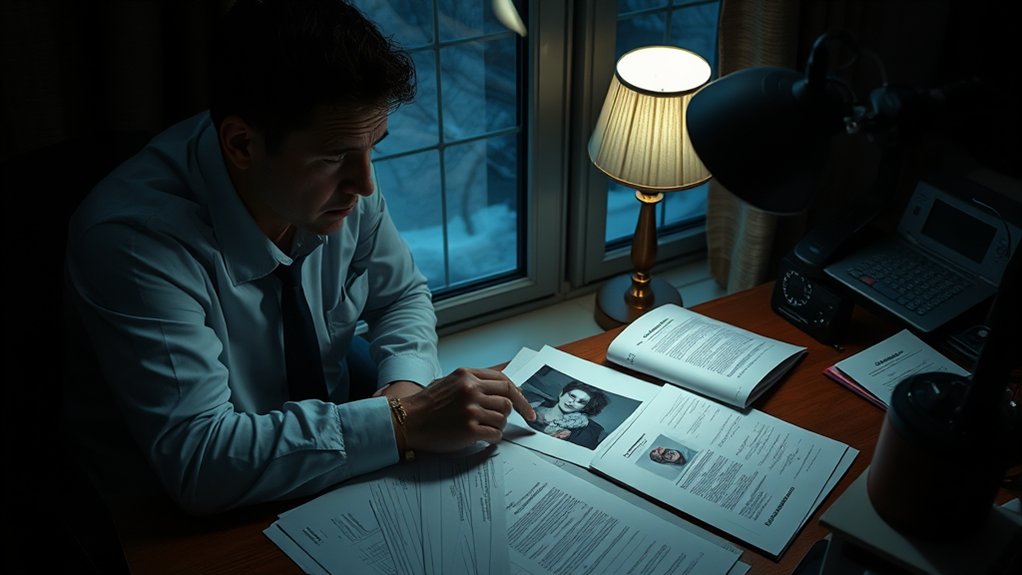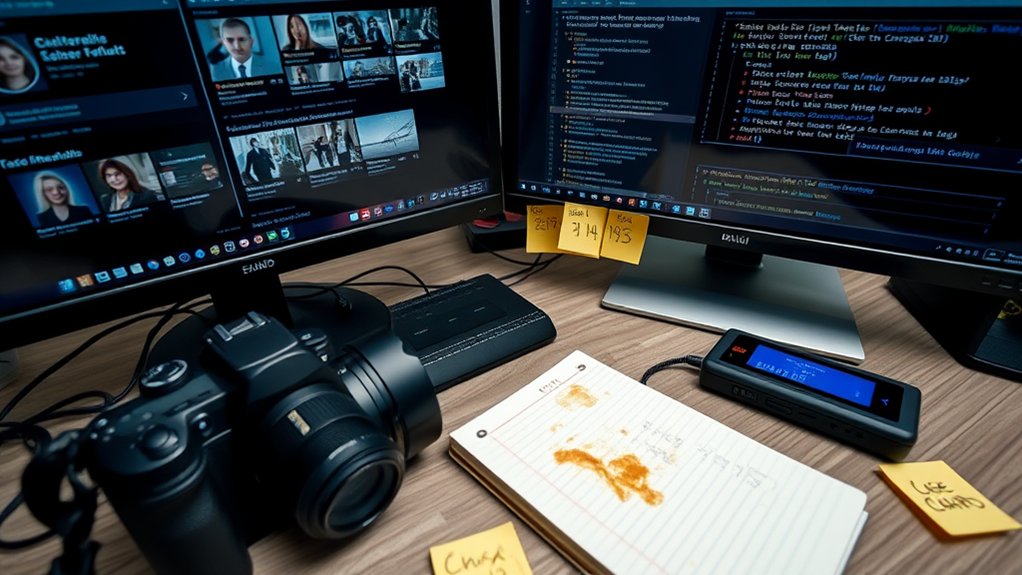Private investigators employ specialized methods in child abuse cases through systematic evidence gathering, surveillance, and coordination with legal authorities. They conduct thorough background checks, utilize digital forensics, and implement trauma-informed interviewing techniques when working with vulnerable children. These professionals maintain detailed documentation while following strict confidentiality protocols and ethical guidelines. Their extensive approach integrates advanced investigative skills, child psychology knowledge, and legal expertise to protect young victims and support justice.
Key Takeaways
- Private investigators collaborate with legal teams and child services to gather evidence, conduct surveillance, and interview witnesses in abuse cases.
- Investigators use trauma-informed interviewing techniques and age-appropriate questioning to obtain accurate information from child victims.
- Digital evidence collection includes monitoring social media, analyzing communications, and securing crucial data from children’s devices.
- Thorough background checks are conducted on suspects and their associates, including criminal records, court documents, and residence history.
- Investigators maintain strict confidentiality while documenting evidence, following chain-of-custody protocols, and preparing comprehensive case reports.
The Role of Private Investigators in Child Abuse Cases

Private investigators play a vital support role in child abuse investigations by gathering evidence, conducting surveillance, and interviewing witnesses outside official law enforcement channels. They often work alongside legal teams and child protective services to strengthen cases through detailed evidence analysis and documentation of suspected abuse patterns.
These investigators utilize specialized skills to locate witnesses who may be hesitant to speak with authorities, document living conditions, and verify claims made by involved parties. Their work frequently contributes to case resolution by providing additional layers of documentation and testimony that may not be obtainable through standard law enforcement procedures. Private investigators also assist in background checks of suspected abusers, monitoring compliance with court orders, and gathering digital evidence from social media and electronic communications. When evidence of abuse is discovered, investigators help ensure proper evidence handling by viewing recordings privately and coordinating with local authorities to preserve crucial documentation.
Essential Skills and Qualifications for Child Abuse Investigators
Child abuse investigators must possess specific qualifications and competencies to effectively carry out their investigative duties. Core requirements include formal education in criminal justice, psychology, or social work, combined with specialized training in investigative techniques and trauma-informed approaches.
Successful investigators demonstrate strong interviewing abilities, particularly when working with vulnerable children and families. They maintain detailed documentation skills, analytical thinking, and emotional resilience while handling sensitive cases. Knowledge of child development, behavioral indicators of abuse, and current legal frameworks is essential.
Professional certification and ongoing education in areas such as forensic interviewing, evidence collection, and child advocacy further enhance investigative capabilities. Investigators must also develop cultural competency and maintain professional boundaries while building rapport with affected individuals and collaborating agencies. Investigation findings must be gathered with strict legal compliance to ensure admissibility as evidence in court proceedings.
Specialized Surveillance Techniques for Child Safety
Surveillance techniques for investigating child abuse cases require specific protocols to protect minors while gathering evidence. Digital tracking methods allow investigators to monitor potential threats through social media activity and electronic communications in accordance with legal requirements. School zone monitoring and strategic camera placement must follow strict guidelines that maintain student privacy while identifying suspicious behavior patterns. Digital forensics experts can detect and remove hidden spyware used to monitor children’s activities on mobile devices.
Digital Movement Tracking Methods
Modern digital tracking methods enable investigators to monitor the movement patterns and location data of persons of interest in child safety cases. Through GPS tracking devices and digital forensics analysis, investigators can establish detailed timelines of suspect movements and identify potential safety risks to children.
These tracking methods include analyzing cellular tower data, monitoring social media check-ins, and reviewing digital footprints left by mobile devices and applications. When legally authorized, investigators can deploy covert GPS units or leverage existing device tracking features to maintain real-time awareness of subject locations. The collected data helps verify alibis, document suspicious pattern behaviors, and coordinate with law enforcement when immediate intervention becomes necessary. This digital evidence often proves vital in building thorough cases and protecting vulnerable children from potential harm.
Covert School Zone Monitoring
Law enforcement agencies deploy specialized monitoring systems around school zones to identify and track suspicious activities that may threaten student safety. Through community involvement and school collaboration, these surveillance methods enhance protection while maintaining student privacy.
- Strategic placement of covert cameras at key entry points, drop-off zones, and perimeter locations allows security teams to monitor unauthorized individuals approaching school grounds
- Mobile surveillance units staffed by trained officers conduct random patrols during peak hours, documenting unusual patterns or repeated presence of unknown vehicles
- Real-time data sharing between school security personnel and law enforcement enables rapid response to potential threats while maintaining discretion
This systematic approach creates multiple layers of protection without disrupting daily school operations, fostering a secure environment where students can focus on learning.
Hidden Camera Best Practices
When implementing hidden camera systems for child safety, institutions must adhere to strict protocols that balance investigative needs with legal and ethical requirements. Hidden camera placement requires careful consideration of privacy zones, confirming surveillance occurs only in public or authorized areas. Administrative approval and proper documentation are essential before installation.
Hidden camera legality varies by jurisdiction, but generally prohibits recording in private spaces like restrooms or changing areas. Institutions should consult legal counsel to verify compliance with state surveillance laws and obtain necessary permits. Camera systems must be properly secured to prevent unauthorized access to footage, with strict protocols governing data retention and deletion. Regular system audits help maintain compliance and confirm cameras function as intended while respecting privacy boundaries.
Digital Evidence Collection and Social Media Monitoring

Digital evidence collection and social media monitoring have become essential components in child abuse investigations, enabling investigators to gather significant electronic data from devices, online accounts, and social platforms. Through careful digital footprint analysis and monitoring of social media behaviors, investigators can identify patterns, connections, and potential evidence of abuse or exploitation.
- Investigators systematically preserve and analyze digital communications, including chat logs, emails, and direct messages that may contain critical evidence of grooming or abuse.
- Social media activity tracking reveals relationship dynamics, suspicious interactions, and attempts to contact minors.
- Advanced forensic tools extract metadata, deleted content, and location data from devices to establish timelines and verify alibis.
Professional monitoring of digital spaces requires strict adherence to legal protocols while maintaining chain of custody for all collected evidence. Investigators can complete mobile device acquisitions within an hour to quickly secure potentially crucial evidence in abuse cases.
Interviewing Methods for Child-Related Cases
Conducting effective interviews with children in abuse investigations requires specialized training and developmentally-appropriate techniques to obtain reliable testimony while preventing additional trauma. Investigators must apply established child psychology principles and adapt their interviewing techniques based on the child’s age, cognitive development, and emotional state. Independent verification through multiple interview sessions helps establish consistent patterns of testimony and behavior.
| Interview Phase | Purpose | Key Considerations |
|---|---|---|
| Rapport Building | Create trust and safety | Use age-appropriate language |
| Free Narrative | Allow child-led disclosure | Avoid leading questions |
| Specific Inquiry | Gather detailed information | Maintain neutral tone |
Professional investigators employ structured protocols like NICHD or RATAC to guarantee consistency and reliability. Questions progress from open-ended to focused inquiries, while maintaining a supportive environment. Non-verbal communication tools, such as anatomically correct dolls or drawing materials, may supplement verbal interviews when developmentally appropriate.
Coordinating With Law Enforcement and Child Services
Successful child abuse investigations require seamless coordination between law enforcement agencies and child protective services to ascertain thorough case management and victim support. Establishing clear communication protocols and collaborative strategies guarantees that all involved parties maintain professional standards while working toward the common goal of protecting vulnerable children.
- Investigators must participate in regular case review meetings with law enforcement and child services representatives to share critical findings and coordinate next steps
- Documentation and evidence must flow systematically between agencies through secure, established channels to maintain chain of custody
- All team members must follow strict confidentiality guidelines while sharing essential information that serves the child’s best interests
These coordinated efforts help prevent re-traumatization of victims and strengthen the overall investigation process through unified expertise and resources. Following ethical investigation principles ensures the protection of victims’ privacy rights while maintaining the integrity needed for legal proceedings.
Background Investigation Protocols and Red Flags

Investigators must verify the background histories of all individuals who regularly interact with the child, examining both criminal records and civil documentation. Key warning signs include frequent changes in residence, inconsistent employment patterns, and prior allegations of misconduct with minors. Document searches should focus on court records, professional licenses, and institutional affiliations while noting any attempts to conceal or falsify information. Experienced investigators at Stillinger Investigations utilize call detail records and comprehensive activity checks to establish patterns of behavior and verify claims made by involved parties.
Verifying Known Associates’ History
When investigating allegations of child abuse, thorough background checks on all known associates of the suspected perpetrator serve as a critical component of the investigative process. Investigators analyze historical associations and behavioral patterns to identify potential risks or connections that may impact child safety.
Professional investigators must verify:
- Criminal records and prior allegations involving associates who have regular access to the child
- Employment history and references of individuals who frequently interact with the suspected perpetrator
- Social media connections and digital footprints that reveal concerning relationships or activities
This systematic examination of known associates helps establish a complete understanding of the environment surrounding the child. Investigators document all findings methodically, ensuring full verification of information through multiple authoritative sources while maintaining strict confidentiality throughout the process.
Document Search Warning Signs
Background investigations must include systematic review of key documents for potential warning signs that could indicate child abuse or endangerment. Various document types require careful scrutiny, including medical records, school attendance reports, counseling notes, and disciplinary records.
Investigators should analyze these materials for warning indicators such as frequent unexplained injuries, patterns of school absences following weekends or holidays, sudden behavioral changes noted in counseling sessions, and inconsistent explanations for injuries documented across different records. Additional red flags may appear in financial records showing unusual purchases, police reports involving domestic disturbances, or custody agreements with concerning stipulations. Cross-referencing these documents helps establish timelines and identify patterns that might otherwise remain obscured when examining records in isolation.
Documentation and Evidence Handling Best Practices
Proper documentation and evidence handling form the foundation of successful child abuse investigations. Investigators must maintain detailed records while following strict evidence preservation protocols to guarantee case integrity. Thorough case documentation includes photographs, written statements, and chronological timelines of all investigative activities.
- Each piece of evidence must be properly labeled, photographed in place, and secured using approved collection methods to maintain chain of custody.
- Investigators should document exact times, dates, locations, and individuals present during evidence collection using standardized forms.
- All digital files, physical documents, and evidence items require secure storage with restricted access and complete transfer documentation.
These methodical practices protect evidence admissibility while creating a clear record that supports prosecution efforts and helps protect vulnerable children from further harm. Working with experienced private investigators in Myrtle Beach ensures timely and accurate evidence gathering that strengthens legal outcomes in child abuse cases.
Legal Considerations and Ethical Guidelines
Legal and ethical guidelines serve as critical boundaries that govern all aspects of child abuse investigations. Investigators must operate within established legal frameworks while upholding their ethical obligations to protect vulnerable children, maintain confidentiality, and guarantee proper handling of sensitive information.
Private investigators must understand mandated reporting requirements, child protection laws, and admissible evidence standards. They should obtain necessary permits, follow jurisdictional regulations, and coordinate with law enforcement when required. Ethical considerations include maintaining professional boundaries, avoiding retraumatization of victims, and protecting the privacy of all parties involved.
Documentation must comply with legal standards while respecting ethical principles regarding consent, record-keeping, and information sharing. Investigators should regularly review current legislation and participate in professional development to stay informed of evolving legal and ethical requirements. Professional agencies like Stillinger Investigations emphasize ethical conduct and detailed reporting while maintaining strict client confidentiality.
Frequently Asked Questions
What Is the Average Cost of Hiring a Child Abuse Investigator?
Average fees for child abuse investigators typically range from $75-150 per hour, with total investigation expenses varying between $2,000-10,000 depending on case complexity and required surveillance hours.
How Long Does a Typical Child Abuse Investigation Take to Complete?
Investigation timelines vary considerably based on case complexities, typically ranging from 30 to 90 days. More intricate cases involving multiple witnesses or jurisdictions may extend several months to complete.
Can Private Investigators Testify in Child Abuse Court Cases?
Qualified private investigators can provide court testimony in child abuse cases when properly credentialed and following established protocols. Their investigator qualifications, evidence collection methods, and professional experience must meet legal standards.
What Percentage of Child Abuse Investigations Result in Successful Prosecutions?
Research indicates successful outcomes in child abuse prosecutions vary greatly, with prosecution rates typically ranging between 25-35% of investigated cases that proceed through the criminal justice system.
Do Private Investigators Require Special Insurance for Child Abuse Cases?
Professional investigators typically require specialized insurance types, including enhanced liability coverage and errors/omissions protection, when handling sensitive cases involving minors to safeguard against unique legal and professional risks.
Conclusion
Private investigators play an essential role in child abuse investigations through specialized skills, ethical practices, and coordinated efforts with authorities. Their methodical approach to evidence collection, surveillance, and interviewing, combined with digital monitoring capabilities, strengthens child protection efforts. By maintaining strict documentation protocols and adhering to legal guidelines, investigators help guarantee thorough, admissible evidence while protecting vulnerable victims throughout the investigative process.






